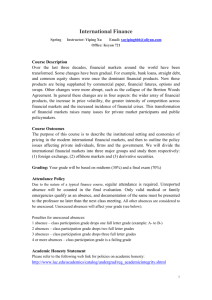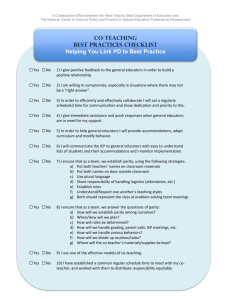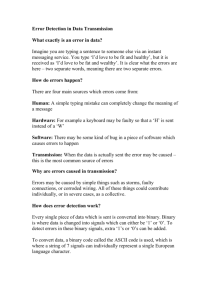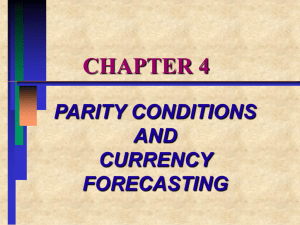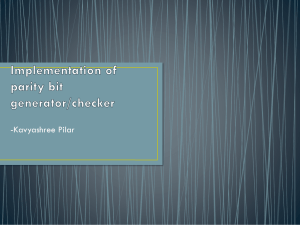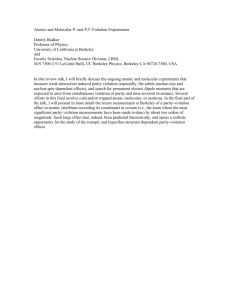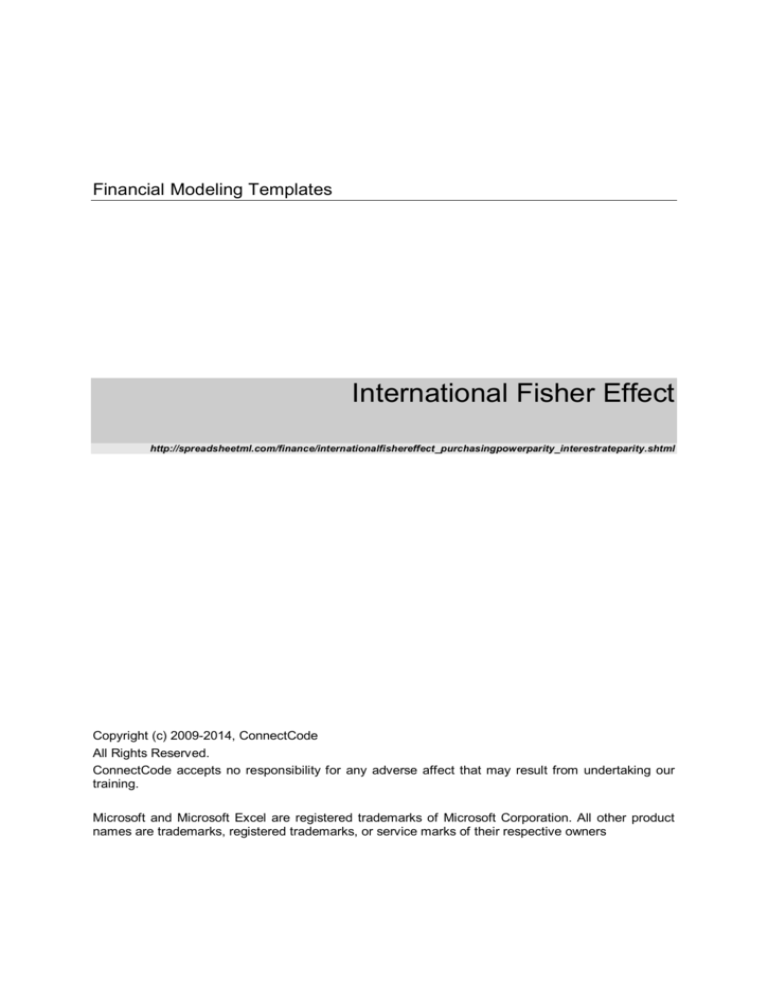
Financial Modeling Templates
International Fisher Effect
http://spreadsheetml.com/finance/internationalfishereffect_purchasingpowerparity_interestrateparity.shtml
Copyright (c) 2009-2014, ConnectCode
All Rights Reserved.
ConnectCode accepts no responsibility for any adverse affect that may result from undertaking our
training.
Microsoft and Microsoft Excel are registered trademarks of Microsoft Corporation. All other product
names are trademarks, registered trademarks, or service marks of their respective owners
Table of Contents
1.
2.
3.
Purchasing Power Parity ................................................................................................. 1-1
1.1
The Law of One Price ............................................................................................ 1-1
1.2
Purchasing Power Parity........................................................................................ 1-1
1.3
Relative Purchasing Power Parity .......................................................................... 1-1
1.3.1 Relative Purchasing Power Parity spreadsheet ......................................... 1-1
Interest Rate Parity .......................................................................................................... 2-2
2.1
Interest Rate Parity ................................................................................................ 2-2
2.2
Interest Rate Parity spreadsheet ............................................................................ 2-2
International Fisher Effect ............................................................................................... 3-3
3.1
International Fisher Effect ...................................................................................... 3-3
3.2
International Fisher Effect spreadsheet .................................................................. 3-3
Pg ii
International Fisher Effect
Version 1.0
ConnectCode’s Financial Modeling Templates
Have you thought about how many times you use or reuse your financial models? Everyday, day
after day, model after model and project after project. We definitely have. That is why we build all
our financial templates to be reusable, customizable and easy to understand. We also test our
templates with different scenarios vigorously, so that you know you can be assured of their
accuracy and quality and that you can save significant amount of time by reusing them. We have
also provided comprehensive documentation on the templates so that you do not need to guess or
figure out how we implemented the models.
All our template models are only in black and white color. We believe this is how a professional
financial template should look like and also that this is the easiest way for you to understand and
use the templates. All the input fields are marked with the ‘*’ symbol for you to identify them
easily.
Whether you are a financial analyst, investment banker or accounting personnel. Or whether you
are a student aspiring to join the finance world or an entrepreneur needing to understand finance,
we hope that you will find this package useful as we have spent our best effort and a lot of time in
developing them.
ConnectCode
Pg iii
International Fisher Effect
Version 1.0
1.
1.1
Purchasing Power Parity
The Law of One Price
The Law of One Price states that in an efficient market where there is free flow of goods, services and
capital a commodity has only one price regardless of the country in which it is purchased. The idea
behind the Law of One Price is that if a commodity costs more in one country than the other, arbitrage
will be possible by moving the commodity from the country with lower price to the one with the higher
price.
1.2
Purchasing Power Parity
The Purchasing Power Parity is based on the Law of One Price. It states that exchange rate will
adjust so that a commodity will cost the same regardless of the country in which it is purchased in.
1.3
Relative Purchasing Power Parity
Relative Purchasing Power Parity further evolved from the concept of Purchasing Power Parity.
Basically it relates the concept of Purchasing Power Parity with the concept of inflation. It states that
the inflation in one country over the inflation of the other country determines the exchange rate
between these two countries.
1.3.1
Relative Purchasing Power Parity spreadsheet
Based on the Relative Purchasing Power Parity, the expected exchange rate in the future is
calculated as follows:
Expected exchange rate in the future = Current Spot Exchange Rate * ((1 + (Inflation of Foreign
County - Inflation of Home Country)) ^ Number of Periods)
In the spreadsheet, the following formula is used to calculate the Expected exchange rate in N
periods.
=F4*((1+(F6-F5))^F7)
Pg 1-1
International Fisher Effect
Version 1.0
2.
2.1
Interest Rate Parity
Interest Rate Parity
The Interest Rate Parity states that the interest rate difference between two countries is equal to the
percentage difference between the forward exchange rate and the spot exchange rate.
The formula for the Interest Rate Parity is shown below. This is also the formula used by the
InterestRateParity worksheet.
Forward exchange rate for settlement at period N = Current Spot Exchange Rate * ((1+Foreign
country nominal risk free interest rate)/(1+US nominal risk free interest rate))
2.2
Interest Rate Parity spreadsheet
An approximation of the exchange rate which supports N periods is calculated in the
InterestRateParityApproximation worksheet. The formula used is as below :
Forward exchange rate for settlement at period N
= Current Spot Exchange Rate*((1+(Foreign country nominal risk free interest rate-US nominal risk
free interest rate)) ^ Number of Periods)
Pg 1-2
International Fisher Effect
Version 1.0
3.
3.1
International Fisher Effect
International Fisher Effect
Both the Interest Rate Parity theory and the Purchasing Power Parity theory allows us to estimate the
future expected exchange rate. The Interest Rate Parity theory relates exchange rate with risk free
interest rates while the Purchasing Power Parity theory relates exchange rate with inflation rates.
Putting them together basically tell us that risk free interest rates are related to inflation rates.
This brings us to the International Fisher Effect. The International Fisher Effect states that the real
interest rates are equal across countries. Real interest rates are approximately the risk free rate minus
the inflation rate.
3.2
International Fisher Effect spreadsheet
The InternationalFisherEffect table worksheets simply approximate the real interest rates of a foreign
country compared to US.
Pg 1-3
International Fisher Effect
Version 1.0



